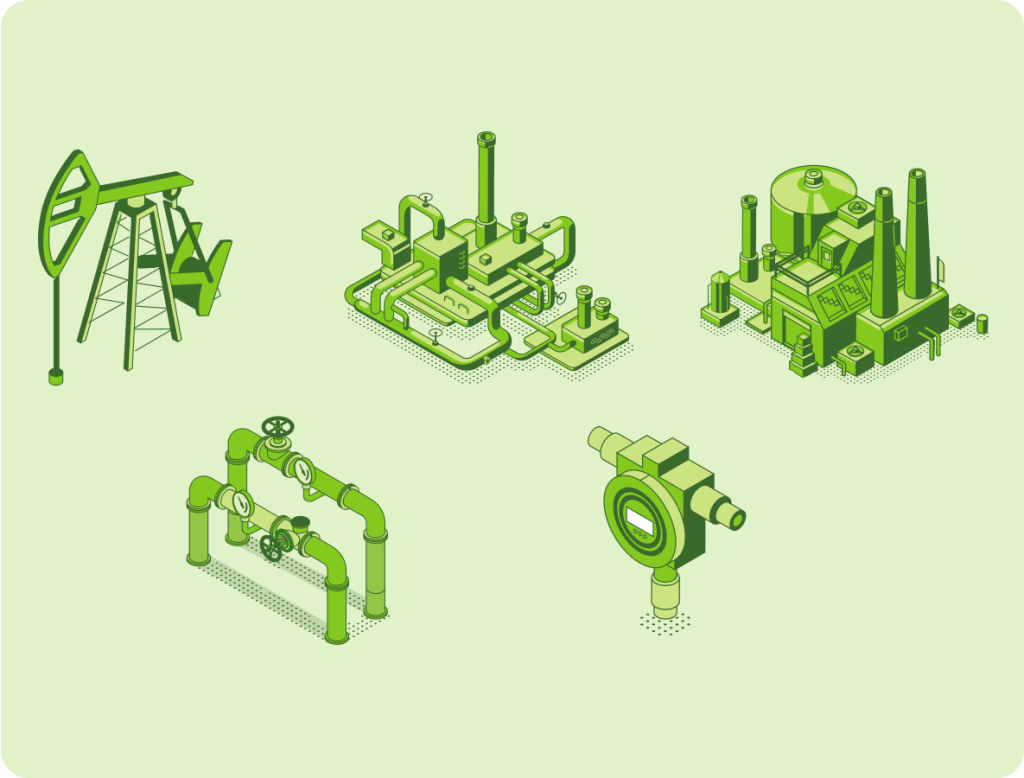Resources
Learn more about the natural gas value chain, ONE Future, and our members’ innovation to reduce methane emissions through the additional resources below.
Case Studies | Protocols | Technologies | Issue One-Pagers | Natural Gas Value Chain | Industry Resources

Case Studies
ONE Future members are reducing methane emissions across the value chain through innovative technologies and shared best practices. See what this looks like for some of our members.
Protocols
ONE Future’s methane intensity protocols and protocols on partnerships, the EPA and other key industry issues.


Technologies
Through 83 unique methane abatement activities across segments, our member companies are leading the way in driving down emissions across the natural gas value chain. Since 2016, ONE Future’s catalogue of abatement strategies and technologies has skyrocketed from 11 to 83 – a sevenfold increase.
Issue One-Pagers
Learn about ONE Future’s perspective on specific, timely issues affecting the natural gas industry, such as the opportunities and limitations of satellites for methane emissions detection.


Natural Gas Value Chain
ONE Future members span five segments of the natural gas value chain: Production, Gathering & Boosting, Processing, Transmission & Storage, and Distribution.
Industry Resources
Learn more about the agencies, programs, and frameworks shaping and affecting the natural gas industry.
Frequently Asked Questions
Answers to our most common questions, ranging from ONE Future’s goal, to our membership, to how we’ve established segment targets.
What is the ONE Future Coalition?
ONE Future is the trade name for “Our Nation’s Energy Future Coalition, Inc.,” a coalition of companies from across the natural gas value chain focused on identifying policy and technical solutions that yield continuous improvement in the management of methane emissions associated with the production, processing, transmission, and distribution of natural gas. If adopted widely, our system of emissions management could lower total methane emissions to less than one percent of gross production and delivery – the point at which the use of natural gas for any purpose provides clear and immediate GHG-reduction benefits as compared to any other fossil fuel in any other application.
Are any NGOs or trade associations members of ONE Future?
No. Membership in ONE Future is limited to companies from all segments of the natural gas supply chain that have operations in the production, gathering and processing, transmission and storage, or distribution segments of the natural gas industry. Our by-laws prohibit any NGO or trade association to be a member. However, ONE Future would consider an advisory panel providing technical guidance [not policy] to our work products and members.
What is the goal of ONE Future?
ONE Future is focused on demonstrating an innovative, performance- and science-based approach to the management of methane emissions directed toward a concrete goal: to achieve an average rate of methane emissions across the entire natural gas value chain that is one percent or less of total (gross) natural gas production and delivery. (To put this in perspective, the EPA estimates that the natural gas industry’s average rate of methane emissions is approximately 1.3 percent of gross production today – an emissions rate which equates to roughly 360 billion cubic feet (BCF) per year.)
Why does ONE Future aspire to a 1% leak/loss rate, and not some other target?
We chose the 1% target for several related reasons:
- Feasibility. We believe that an emissions intensity rate of one percent or less is ambitious, but achievable using existing technology and practices.
- Scientific research. A well-known peer-reviewed study published in the Proceedings of the National Academy of Sciences entitled, “Greater focus needed on methane leakage from natural gas infrastructure” (Alvarez et al.) suggested that in order for natural gas usage to provide immediate greenhouse gas reduction benefits as compared to any other fossil fuel in any other application, the industry would have to achieve a leak/loss rate of one percent or less. While ONE Future members do not unequivocally accept every conclusion of that paper, we believe it is sufficiently robust to serve as a guidepost for our aspirational targets.
- Public acceptance. We strive for continuous improvement in order to ensure that natural gas remains the fuel of choice for any end-use segment at all times: power – including natural gas delivered by local distribution companies for power generation; residential, commercial and industrial demand; and important emerging markets like transportation and LNG exports.
- Affordability. Finally, we believe that the industry can cost-effectively achieve an average emissions intensity rate of one percent. Eliminating all emissions would be both technically infeasible and economically untenable. However, ONE Future believes that targeted investment in abatement technologies today can both yield significant improvements in environmental performance and supply chain efficiency – and that’s just good business.
If emissions differ across industry segments, will reduction targets also vary between segments?
Yes. ONE Future’s approach will establish segment-specific emission reduction targets that are in rough, but not direct proportion to that segment’s respective share of total emissions and the reduction potentials considering current regulatory barriers.
How will ONE Future’s “segment targets” be established?
Under the ONE Future approach, each of the five industry segments aims for emission reduction targets that are in rough, but not direct proportion to their respective share of total emissions and reduction potentials, considering current regulatory barriers. Each of ONE Future’s member companies seek to provide maximum value to the consumer, and it is for that reason that our approach to reducing methane emissions is focused on identifying and addressing the most cost-effective emission sources. Because the cost-effective opportunities to reduce emissions are not necessarily distributed equally among industry segments, each segment’s reduction target may be adjusted slightly to reflect those realities. ONE Future has commissioned independent technical studies by leading researchers in the field that will determine specific emission reduction targets for each segment. However, as detailed above, our overall goal is clear: an industry-wide average emissions intensity equivalent to one percent or less of gross US natural gas production and delivery.
How does an individual company translate ONE Future’s industry-wide emission target into a company-specific goal?
ONE Future companies will be guided by their respective segment’s target rate. For example: an exploration and production company will seek to achieve an average rate of emissions that is at or below the segment target for the exploration and production segment. Once segment targets are established, each company will examine its emissions profile across its covered operations, looking for emissions sources and identifying abatement opportunities. Each company then has the flexibility to determine the most cost-effective pathway to achieve its segment target considering its own particular operations and plans. This flexibility is crucial, as the latest science demonstrates that there are many factors that could determine a company’s emissions profile – and those factors will cause reduction/abatement strategies to vary from one operational area to another and from one company to another. Commercial considerations may render emission reductions at one facility cost-prohibitive, while similar alterations at a different facility may make sense. That is why ONE Future’s emission reduction goals are focused on reducing the corporate-wide average emissions rate relative to the segment emissions target. In short, ONE Future is not a “one size fits all” program that simply mandates the implementation of a certain technology or replacement of a certain emitting device. Rather, we are focused on overall performance that achieves the greatest reductions at the lowest cost – and our members will demonstrate progress according to specific reporting and verification protocols (which are under development).
Why are you focused on reducing your rate of emissions as opposed to your total volume?
While reducing one’s rate of emissions is not incompatible with reducing one’s total volume of emissions, using a mass-based metric of measurement is problematic for several reasons. First, emission rates are the only way to meaningfully benchmark performance between companies and across industry segments. A focus on volumes fails to capture the differences between large and small companies, among other important factors. Second, our companies are in the business of producing, processing, transporting, and supplying natural gas – and our businesses are focused on achieving growth, while relentlessly striving for continuous improvement in operational excellence, safety, environmental performance, and customer satisfaction.
How is a company’s target emissions rate determined?
ONE Future focuses on ensuring that total methane emissions from across the entire gas value chain will eventually amount to less than 1 percent of gross natural gas production. Each industry segment’s reduction target is determined by their proportional share of current emissions that can be abated cost-effectively. Participating companies then implement measures to ensure that their emissions are reduced to or below their segment’s sub-target. ONE Future focuses on achieving results with credibility. Companies will document and report progress under ONE Future’s approach but the ONE Future approach also allows a company to focus on achieving efficiencies across the entire operation – as a basic business activity, rather than a burden.
Why start with a performance target vs. a known technology?
Setting a performance target allows a company to deploy capital where it will be most effective in reducing emissions. This is important, because most studies clearly show that the majority of methane emissions come from a small fraction of sources. ONE Future’s approach allows companies to focus their resources on identifying and addressing those major sources.
What has ONE Future achieved so far?
Specific recognition in the Obama Administration’s Strategy to Reduce Methane Emissions. During his administration, President Obama announced a series of steps it was going to take to reduce methane emissions. Included in the announcement, was a specific recognition of the ONE Future coalition: “EPA will work with DOE, DOT, and leading companies, individually and through broader initiatives such as the One Future Initiative and the Downstream Initiative, to develop and verify robust commitments to reduce methane emissions. This new effort will encourage innovation, provide accountability and transparency, and track progress toward specific methane emission reduction activities and goals to reduce methane leakage across the natural gas value chain.”
Improved interagency cooperation. In addition to ensuring that ONE Future’s voluntary program is accommodated and acknowledged by the EPA, the Administration has also already commenced work to act on ONE Future’s recommendations to reduce methane emissions by improving coordination between Federal agencies. For instance, we expect that PHMSA and FERC safety mandates will increasingly accommodate EPA’s goals of reducing avoidable methane emissions in conducting pipeline blowdowns.
Industry and Government Collaborations. The National Energy Technology Laboratory (NETL) released its report, Industry Partnerships and Their Role in Reducing Natural Gas Supply Chain Greenhouse Gas Emissions. The report analyzed the greenhouse gas (GHG) profile of the ONE Future facilities and also evaluated methane abatement options.
Key takeaways from the study are the following:
- The study indicated an average life-cycle methane emission rate using the ONE Future protocol to be .67% vs national average methane emission rate of 1.62. Additional cost-effective measures could account for an additional 1.1 Bcf in methane emission reductions.
- If these additional measures are fully realized, the average life-cycle methane emission rate for ONE Future companies will be 0.65%, further enhancing the competitive advantage of US natural gas relative to other countries.
- NETL also computed the life cycle GHG emission results for natural gas through end use (power sector and liquefied natural gas (LNG) delivered). Comparing the results with prior NETL reports, ONE Future companies delivered a gas rate 7-10% lower on a CO2 equivalent intensity basis compared to the “average” US natural gas rate on a 100-year basis, and about 15-18% lower on a 20-year basis.

